Dreyfus/Benner Model and Nursing Expertise
VerifiedAdded on 2020/05/28
|7
|1466
|56
AI Summary
The assignment examines the Dreyfus/Benner Model for understanding nursing expertise development. It delves into the model's stages, emphasizing how nurses acquire knowledge and skills through diverse clinical experiences. The author uses personal reflections and the ETNEP program as examples to illustrate the application of this model in their own professional journey.
Contribute Materials
Your contribution can guide someone’s learning journey. Share your
documents today.
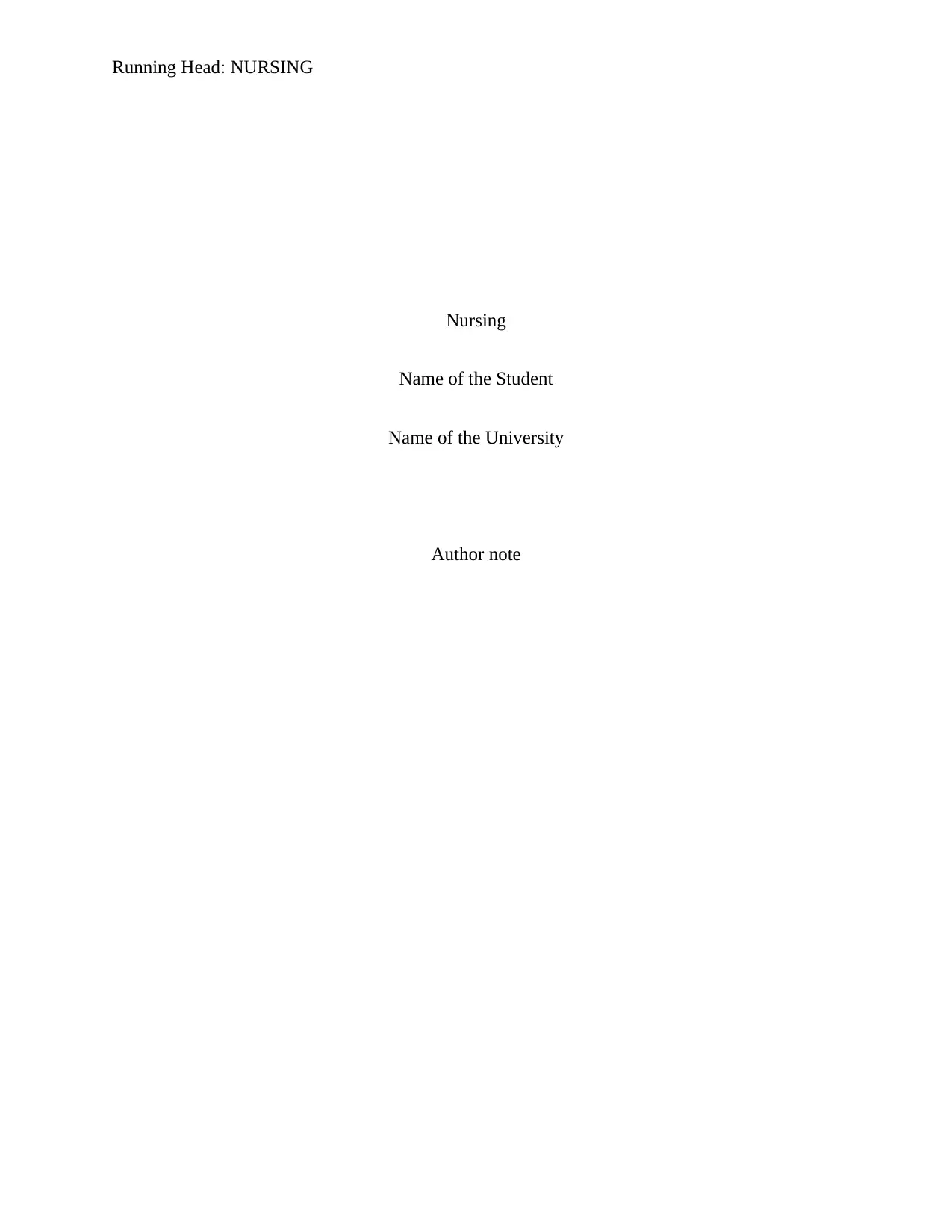
Running Head: NURSING
Nursing
Name of the Student
Name of the University
Author note
Nursing
Name of the Student
Name of the University
Author note
Secure Best Marks with AI Grader
Need help grading? Try our AI Grader for instant feedback on your assignments.
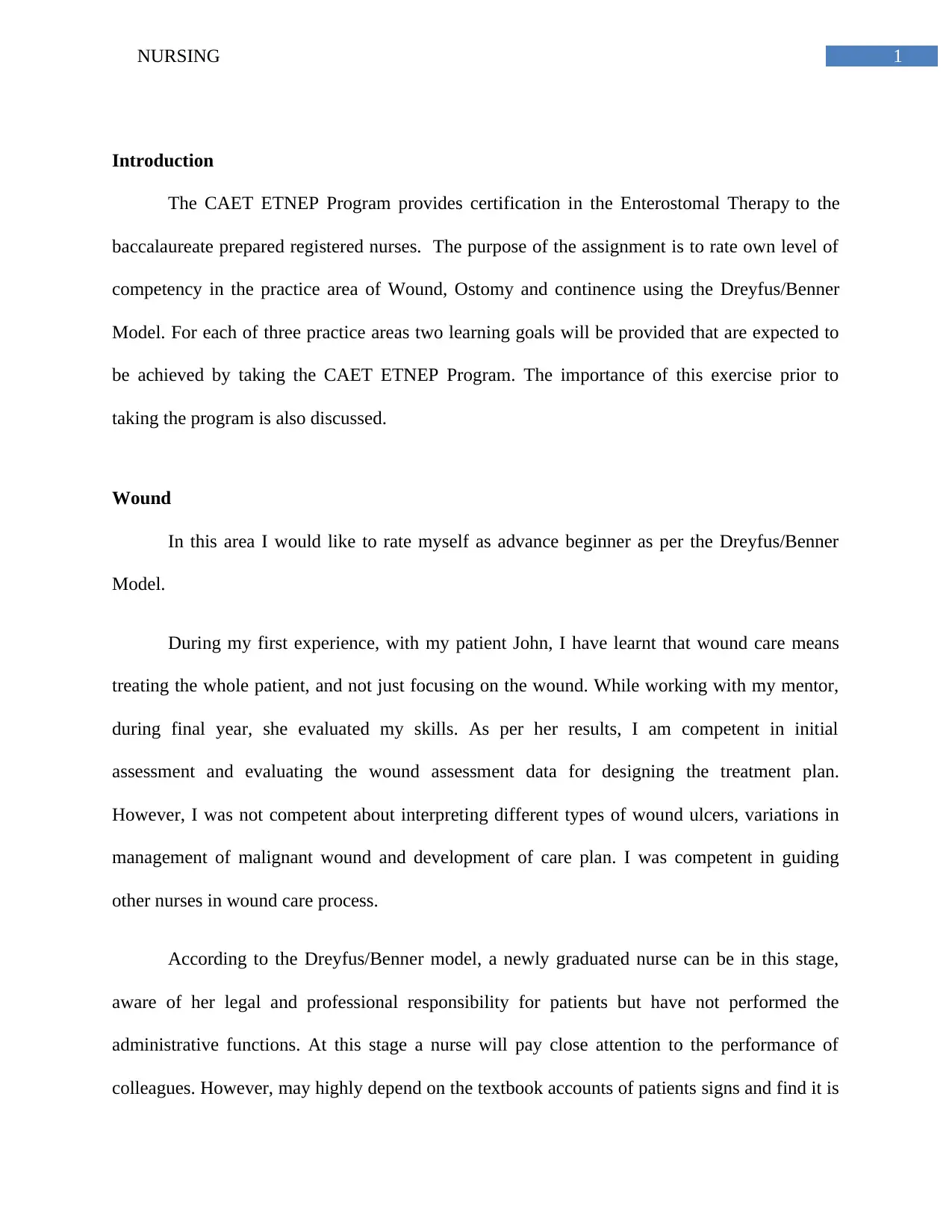
1NURSING
Introduction
The CAET ETNEP Program provides certification in the Enterostomal Therapy to the
baccalaureate prepared registered nurses. The purpose of the assignment is to rate own level of
competency in the practice area of Wound, Ostomy and continence using the Dreyfus/Benner
Model. For each of three practice areas two learning goals will be provided that are expected to
be achieved by taking the CAET ETNEP Program. The importance of this exercise prior to
taking the program is also discussed.
Wound
In this area I would like to rate myself as advance beginner as per the Dreyfus/Benner
Model.
During my first experience, with my patient John, I have learnt that wound care means
treating the whole patient, and not just focusing on the wound. While working with my mentor,
during final year, she evaluated my skills. As per her results, I am competent in initial
assessment and evaluating the wound assessment data for designing the treatment plan.
However, I was not competent about interpreting different types of wound ulcers, variations in
management of malignant wound and development of care plan. I was competent in guiding
other nurses in wound care process.
According to the Dreyfus/Benner model, a newly graduated nurse can be in this stage,
aware of her legal and professional responsibility for patients but have not performed the
administrative functions. At this stage a nurse will pay close attention to the performance of
colleagues. However, may highly depend on the textbook accounts of patients signs and find it is
Introduction
The CAET ETNEP Program provides certification in the Enterostomal Therapy to the
baccalaureate prepared registered nurses. The purpose of the assignment is to rate own level of
competency in the practice area of Wound, Ostomy and continence using the Dreyfus/Benner
Model. For each of three practice areas two learning goals will be provided that are expected to
be achieved by taking the CAET ETNEP Program. The importance of this exercise prior to
taking the program is also discussed.
Wound
In this area I would like to rate myself as advance beginner as per the Dreyfus/Benner
Model.
During my first experience, with my patient John, I have learnt that wound care means
treating the whole patient, and not just focusing on the wound. While working with my mentor,
during final year, she evaluated my skills. As per her results, I am competent in initial
assessment and evaluating the wound assessment data for designing the treatment plan.
However, I was not competent about interpreting different types of wound ulcers, variations in
management of malignant wound and development of care plan. I was competent in guiding
other nurses in wound care process.
According to the Dreyfus/Benner model, a newly graduated nurse can be in this stage,
aware of her legal and professional responsibility for patients but have not performed the
administrative functions. At this stage a nurse will pay close attention to the performance of
colleagues. However, may highly depend on the textbook accounts of patients signs and find it is
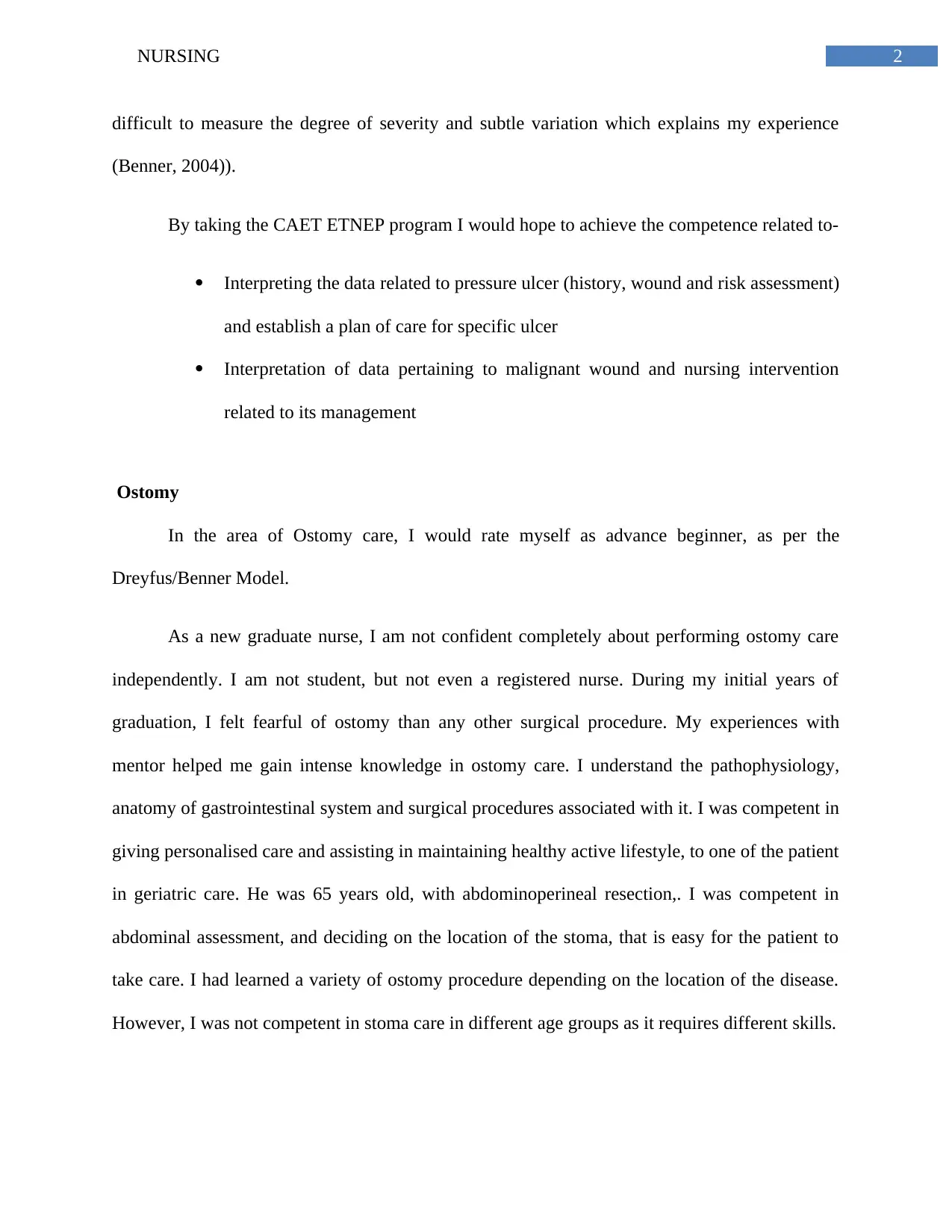
2NURSING
difficult to measure the degree of severity and subtle variation which explains my experience
(Benner, 2004)).
By taking the CAET ETNEP program I would hope to achieve the competence related to-
Interpreting the data related to pressure ulcer (history, wound and risk assessment)
and establish a plan of care for specific ulcer
Interpretation of data pertaining to malignant wound and nursing intervention
related to its management
Ostomy
In the area of Ostomy care, I would rate myself as advance beginner, as per the
Dreyfus/Benner Model.
As a new graduate nurse, I am not confident completely about performing ostomy care
independently. I am not student, but not even a registered nurse. During my initial years of
graduation, I felt fearful of ostomy than any other surgical procedure. My experiences with
mentor helped me gain intense knowledge in ostomy care. I understand the pathophysiology,
anatomy of gastrointestinal system and surgical procedures associated with it. I was competent in
giving personalised care and assisting in maintaining healthy active lifestyle, to one of the patient
in geriatric care. He was 65 years old, with abdominoperineal resection,. I was competent in
abdominal assessment, and deciding on the location of the stoma, that is easy for the patient to
take care. I had learned a variety of ostomy procedure depending on the location of the disease.
However, I was not competent in stoma care in different age groups as it requires different skills.
difficult to measure the degree of severity and subtle variation which explains my experience
(Benner, 2004)).
By taking the CAET ETNEP program I would hope to achieve the competence related to-
Interpreting the data related to pressure ulcer (history, wound and risk assessment)
and establish a plan of care for specific ulcer
Interpretation of data pertaining to malignant wound and nursing intervention
related to its management
Ostomy
In the area of Ostomy care, I would rate myself as advance beginner, as per the
Dreyfus/Benner Model.
As a new graduate nurse, I am not confident completely about performing ostomy care
independently. I am not student, but not even a registered nurse. During my initial years of
graduation, I felt fearful of ostomy than any other surgical procedure. My experiences with
mentor helped me gain intense knowledge in ostomy care. I understand the pathophysiology,
anatomy of gastrointestinal system and surgical procedures associated with it. I was competent in
giving personalised care and assisting in maintaining healthy active lifestyle, to one of the patient
in geriatric care. He was 65 years old, with abdominoperineal resection,. I was competent in
abdominal assessment, and deciding on the location of the stoma, that is easy for the patient to
take care. I had learned a variety of ostomy procedure depending on the location of the disease.
However, I was not competent in stoma care in different age groups as it requires different skills.
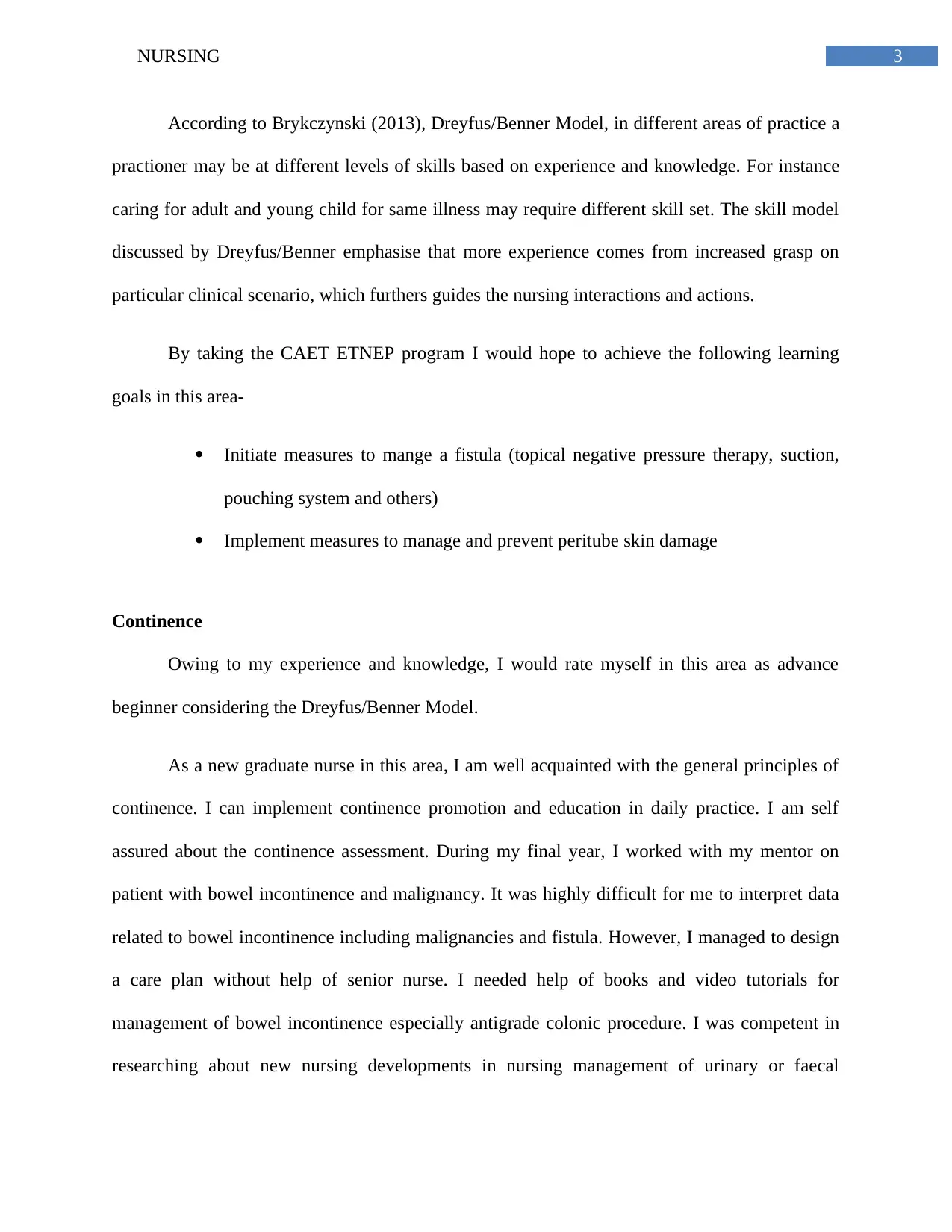
3NURSING
According to Brykczynski (2013), Dreyfus/Benner Model, in different areas of practice a
practioner may be at different levels of skills based on experience and knowledge. For instance
caring for adult and young child for same illness may require different skill set. The skill model
discussed by Dreyfus/Benner emphasise that more experience comes from increased grasp on
particular clinical scenario, which furthers guides the nursing interactions and actions.
By taking the CAET ETNEP program I would hope to achieve the following learning
goals in this area-
Initiate measures to mange a fistula (topical negative pressure therapy, suction,
pouching system and others)
Implement measures to manage and prevent peritube skin damage
Continence
Owing to my experience and knowledge, I would rate myself in this area as advance
beginner considering the Dreyfus/Benner Model.
As a new graduate nurse in this area, I am well acquainted with the general principles of
continence. I can implement continence promotion and education in daily practice. I am self
assured about the continence assessment. During my final year, I worked with my mentor on
patient with bowel incontinence and malignancy. It was highly difficult for me to interpret data
related to bowel incontinence including malignancies and fistula. However, I managed to design
a care plan without help of senior nurse. I needed help of books and video tutorials for
management of bowel incontinence especially antigrade colonic procedure. I was competent in
researching about new nursing developments in nursing management of urinary or faecal
According to Brykczynski (2013), Dreyfus/Benner Model, in different areas of practice a
practioner may be at different levels of skills based on experience and knowledge. For instance
caring for adult and young child for same illness may require different skill set. The skill model
discussed by Dreyfus/Benner emphasise that more experience comes from increased grasp on
particular clinical scenario, which furthers guides the nursing interactions and actions.
By taking the CAET ETNEP program I would hope to achieve the following learning
goals in this area-
Initiate measures to mange a fistula (topical negative pressure therapy, suction,
pouching system and others)
Implement measures to manage and prevent peritube skin damage
Continence
Owing to my experience and knowledge, I would rate myself in this area as advance
beginner considering the Dreyfus/Benner Model.
As a new graduate nurse in this area, I am well acquainted with the general principles of
continence. I can implement continence promotion and education in daily practice. I am self
assured about the continence assessment. During my final year, I worked with my mentor on
patient with bowel incontinence and malignancy. It was highly difficult for me to interpret data
related to bowel incontinence including malignancies and fistula. However, I managed to design
a care plan without help of senior nurse. I needed help of books and video tutorials for
management of bowel incontinence especially antigrade colonic procedure. I was competent in
researching about new nursing developments in nursing management of urinary or faecal
Secure Best Marks with AI Grader
Need help grading? Try our AI Grader for instant feedback on your assignments.
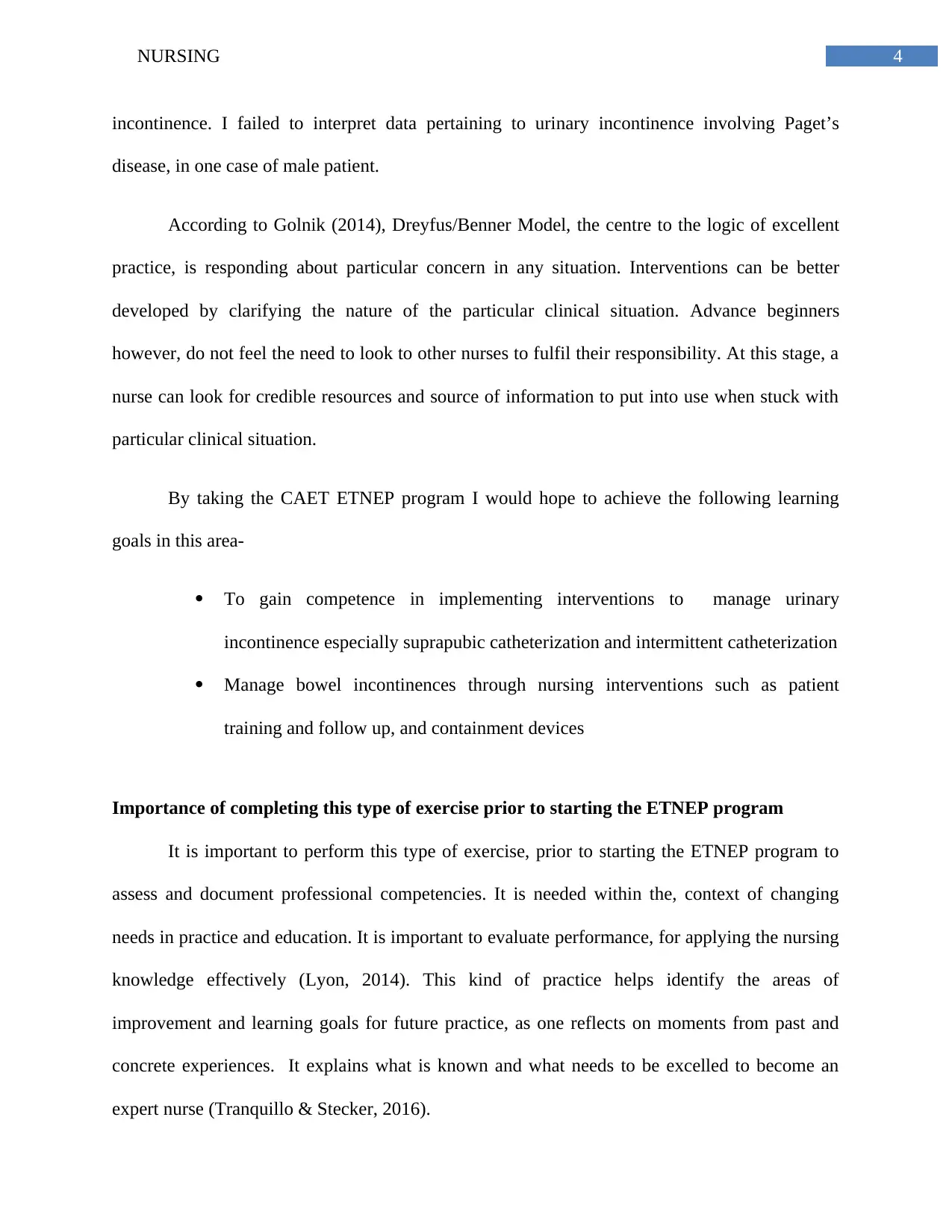
4NURSING
incontinence. I failed to interpret data pertaining to urinary incontinence involving Paget’s
disease, in one case of male patient.
According to Golnik (2014), Dreyfus/Benner Model, the centre to the logic of excellent
practice, is responding about particular concern in any situation. Interventions can be better
developed by clarifying the nature of the particular clinical situation. Advance beginners
however, do not feel the need to look to other nurses to fulfil their responsibility. At this stage, a
nurse can look for credible resources and source of information to put into use when stuck with
particular clinical situation.
By taking the CAET ETNEP program I would hope to achieve the following learning
goals in this area-
To gain competence in implementing interventions to manage urinary
incontinence especially suprapubic catheterization and intermittent catheterization
Manage bowel incontinences through nursing interventions such as patient
training and follow up, and containment devices
Importance of completing this type of exercise prior to starting the ETNEP program
It is important to perform this type of exercise, prior to starting the ETNEP program to
assess and document professional competencies. It is needed within the, context of changing
needs in practice and education. It is important to evaluate performance, for applying the nursing
knowledge effectively (Lyon, 2014). This kind of practice helps identify the areas of
improvement and learning goals for future practice, as one reflects on moments from past and
concrete experiences. It explains what is known and what needs to be excelled to become an
expert nurse (Tranquillo & Stecker, 2016).
incontinence. I failed to interpret data pertaining to urinary incontinence involving Paget’s
disease, in one case of male patient.
According to Golnik (2014), Dreyfus/Benner Model, the centre to the logic of excellent
practice, is responding about particular concern in any situation. Interventions can be better
developed by clarifying the nature of the particular clinical situation. Advance beginners
however, do not feel the need to look to other nurses to fulfil their responsibility. At this stage, a
nurse can look for credible resources and source of information to put into use when stuck with
particular clinical situation.
By taking the CAET ETNEP program I would hope to achieve the following learning
goals in this area-
To gain competence in implementing interventions to manage urinary
incontinence especially suprapubic catheterization and intermittent catheterization
Manage bowel incontinences through nursing interventions such as patient
training and follow up, and containment devices
Importance of completing this type of exercise prior to starting the ETNEP program
It is important to perform this type of exercise, prior to starting the ETNEP program to
assess and document professional competencies. It is needed within the, context of changing
needs in practice and education. It is important to evaluate performance, for applying the nursing
knowledge effectively (Lyon, 2014). This kind of practice helps identify the areas of
improvement and learning goals for future practice, as one reflects on moments from past and
concrete experiences. It explains what is known and what needs to be excelled to become an
expert nurse (Tranquillo & Stecker, 2016).
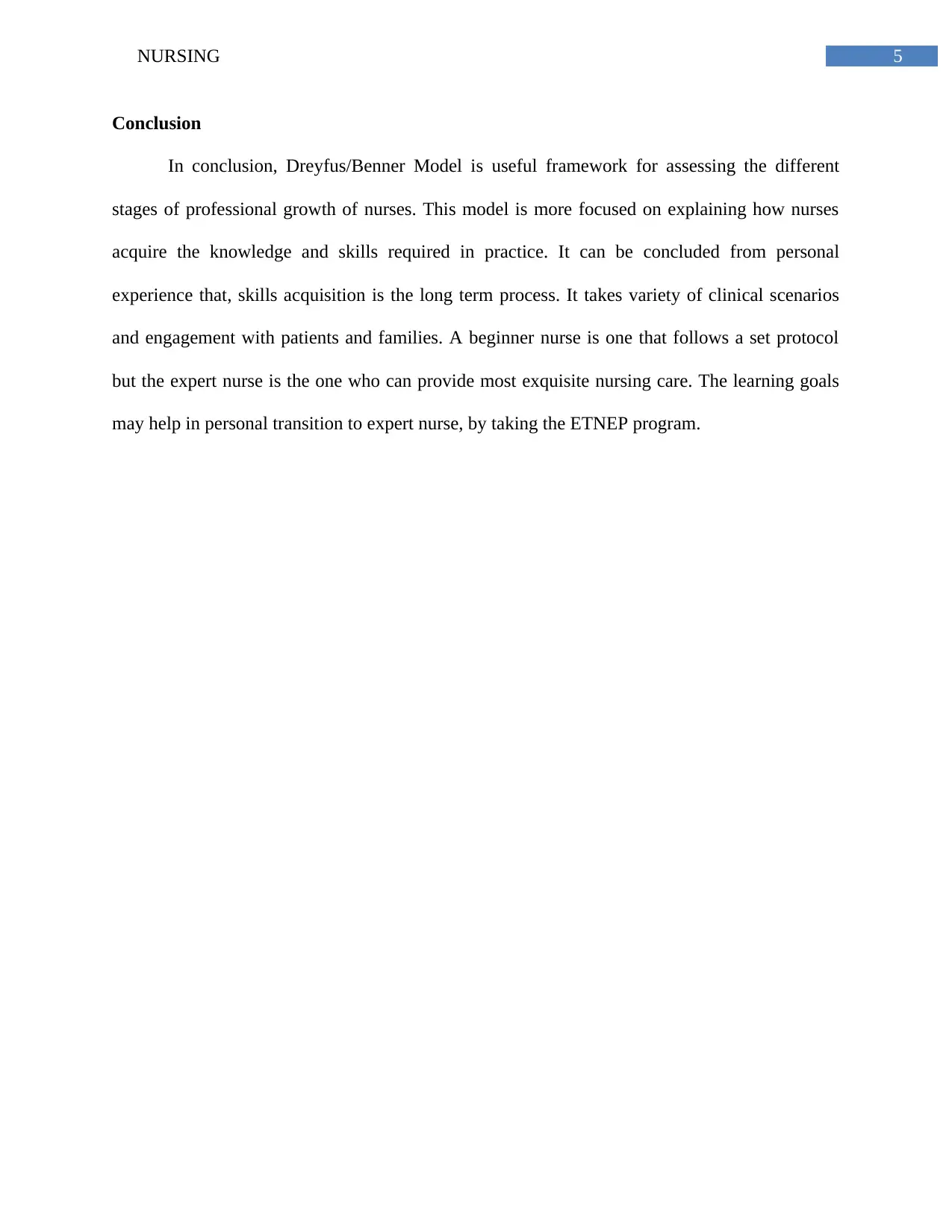
5NURSING
Conclusion
In conclusion, Dreyfus/Benner Model is useful framework for assessing the different
stages of professional growth of nurses. This model is more focused on explaining how nurses
acquire the knowledge and skills required in practice. It can be concluded from personal
experience that, skills acquisition is the long term process. It takes variety of clinical scenarios
and engagement with patients and families. A beginner nurse is one that follows a set protocol
but the expert nurse is the one who can provide most exquisite nursing care. The learning goals
may help in personal transition to expert nurse, by taking the ETNEP program.
Conclusion
In conclusion, Dreyfus/Benner Model is useful framework for assessing the different
stages of professional growth of nurses. This model is more focused on explaining how nurses
acquire the knowledge and skills required in practice. It can be concluded from personal
experience that, skills acquisition is the long term process. It takes variety of clinical scenarios
and engagement with patients and families. A beginner nurse is one that follows a set protocol
but the expert nurse is the one who can provide most exquisite nursing care. The learning goals
may help in personal transition to expert nurse, by taking the ETNEP program.
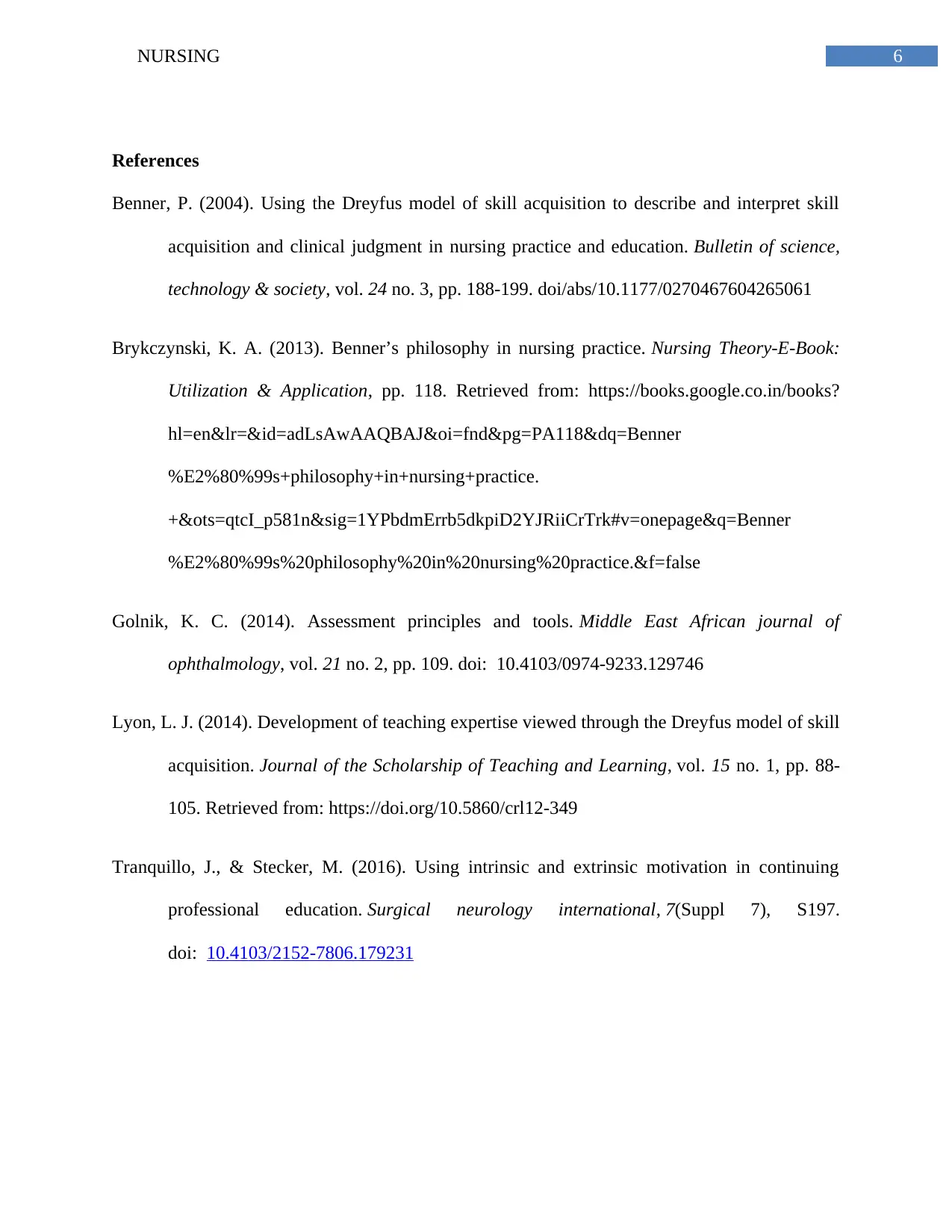
6NURSING
References
Benner, P. (2004). Using the Dreyfus model of skill acquisition to describe and interpret skill
acquisition and clinical judgment in nursing practice and education. Bulletin of science,
technology & society, vol. 24 no. 3, pp. 188-199. doi/abs/10.1177/0270467604265061
Brykczynski, K. A. (2013). Benner’s philosophy in nursing practice. Nursing Theory-E-Book:
Utilization & Application, pp. 118. Retrieved from: https://books.google.co.in/books?
hl=en&lr=&id=adLsAwAAQBAJ&oi=fnd&pg=PA118&dq=Benner
%E2%80%99s+philosophy+in+nursing+practice.
+&ots=qtcI_p581n&sig=1YPbdmErrb5dkpiD2YJRiiCrTrk#v=onepage&q=Benner
%E2%80%99s%20philosophy%20in%20nursing%20practice.&f=false
Golnik, K. C. (2014). Assessment principles and tools. Middle East African journal of
ophthalmology, vol. 21 no. 2, pp. 109. doi: 10.4103/0974-9233.129746
Lyon, L. J. (2014). Development of teaching expertise viewed through the Dreyfus model of skill
acquisition. Journal of the Scholarship of Teaching and Learning, vol. 15 no. 1, pp. 88-
105. Retrieved from: https://doi.org/10.5860/crl12-349
Tranquillo, J., & Stecker, M. (2016). Using intrinsic and extrinsic motivation in continuing
professional education. Surgical neurology international, 7(Suppl 7), S197.
doi: 10.4103/2152-7806.179231
References
Benner, P. (2004). Using the Dreyfus model of skill acquisition to describe and interpret skill
acquisition and clinical judgment in nursing practice and education. Bulletin of science,
technology & society, vol. 24 no. 3, pp. 188-199. doi/abs/10.1177/0270467604265061
Brykczynski, K. A. (2013). Benner’s philosophy in nursing practice. Nursing Theory-E-Book:
Utilization & Application, pp. 118. Retrieved from: https://books.google.co.in/books?
hl=en&lr=&id=adLsAwAAQBAJ&oi=fnd&pg=PA118&dq=Benner
%E2%80%99s+philosophy+in+nursing+practice.
+&ots=qtcI_p581n&sig=1YPbdmErrb5dkpiD2YJRiiCrTrk#v=onepage&q=Benner
%E2%80%99s%20philosophy%20in%20nursing%20practice.&f=false
Golnik, K. C. (2014). Assessment principles and tools. Middle East African journal of
ophthalmology, vol. 21 no. 2, pp. 109. doi: 10.4103/0974-9233.129746
Lyon, L. J. (2014). Development of teaching expertise viewed through the Dreyfus model of skill
acquisition. Journal of the Scholarship of Teaching and Learning, vol. 15 no. 1, pp. 88-
105. Retrieved from: https://doi.org/10.5860/crl12-349
Tranquillo, J., & Stecker, M. (2016). Using intrinsic and extrinsic motivation in continuing
professional education. Surgical neurology international, 7(Suppl 7), S197.
doi: 10.4103/2152-7806.179231
1 out of 7
Your All-in-One AI-Powered Toolkit for Academic Success.
+13062052269
info@desklib.com
Available 24*7 on WhatsApp / Email
![[object Object]](/_next/static/media/star-bottom.7253800d.svg)
Unlock your academic potential
© 2024 | Zucol Services PVT LTD | All rights reserved.


